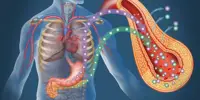Obesity is generally considered more dangerous for men than for women because it is associated with an increased risk of developing several serious health problems, such as heart disease, type 2 diabetes, and certain types of cancer, which are more prevalent in men. Additionally, obesity in men is also linked to a lower life expectancy, as well as a reduced quality of life. However, obesity is a serious health concern for both men and women, and it is important for individuals of all genders to maintain a healthy weight to reduce the risk of developing these and other health problems.
A new York University study sheds light on the biological underpinnings of sex differences in obesity-related disease, with researchers observing “striking” differences in the cells that build blood vessels in male versus female mice’s fatty tissue.
According to York Professor Tara Haas of the Faculty of Health’s School of Kinesiology and Health Science, men are more likely than women to develop obesity-related conditions such as cardiovascular disease, insulin resistance, and diabetes.
“People have used rodent models to study obesity and the diseases associated with obesity, such as diabetes, but they’ve always studied male rodents, because females are resistant to developing the same kinds of diseases,” says Haas, the study’s lead author. “We were very interested in investigating that difference because it spoke to us of something really fascinating going on in females that protects them.”
Our study’s findings can help researchers better understand why obesity manifests differently in men and women. It’s exciting to see how female endothelial cells maintain their resilience even when stressed by a long-term high-fat diet.
Pislaru
In a previous study, Haas and her colleagues discovered that when mice become obese, females grow a lot of new blood vessels to supply the expanding fat tissue with oxygen and nutrients, whereas males grow a lot less. Haas and her co-authors, including York PhD student Alexandra Pislaru, Faculty of Health Assistant Professor Emilie Roudier, and former York post-doctoral student Martina Rudnicki, focused on differences in the endothelial cells that make up the building blocks of these blood vessels in fat tissue in this latest study published in iScience.
The team used software to help sift through thousands of genes to zero in on the ones that would be associated with blood vessel growth. They discovered that processes associated with the proliferation of new blood vessels were high in the female mice, whereas the males had a high level of processes associated with inflammation.

“The extent of inflammation-associated processes that were prevalent in the males was very striking,” Haas recalls. “Other studies have shown that when endothelial cells have that kind of inflammatory response, they become very dysfunctional and do not respond properly to stimuli.”
Pislaru, who works in Haas’ lab and is one of the study’s co-first authors, worked on this project as part of her dissertation. “It’s exciting to see how female endothelial cells maintain their resilience even when stressed by a long-term high-fat diet,” Pislaru says. “Our study’s findings can help researchers better understand why obesity manifests differently in men and women.”
The researchers also studied the behavior of endothelial cells after they were removed from the body and placed in petri dishes. “Even when we take them out of the body, where they don’t have the circulating sex hormones or other kinds of factors, male and female endothelial cells still behave very differently,” Haas says.
Female endothelial cells replicated more quickly, whereas male endothelial cells were more sensitive to an inflammatory stimulus. When compared to previously published data sets, the researchers discovered that endothelial cells from aged male mice had a more inflammatory profile than female cells.
“You can’t assume that both sexes will react the same way to the same series of events,” Haas says. “This isn’t just an obesity problem; I believe it’s a much broader conceptual issue that also includes healthy aging. One implication of our findings is that in some cases, the treatment that is best for men will not be best for women, and vice versa.”
The study was supported by the Canadian Institutes of Health Research, the Natural Sciences and Engineering Research Council of Canada, and York University’s Faculty of Health.
















